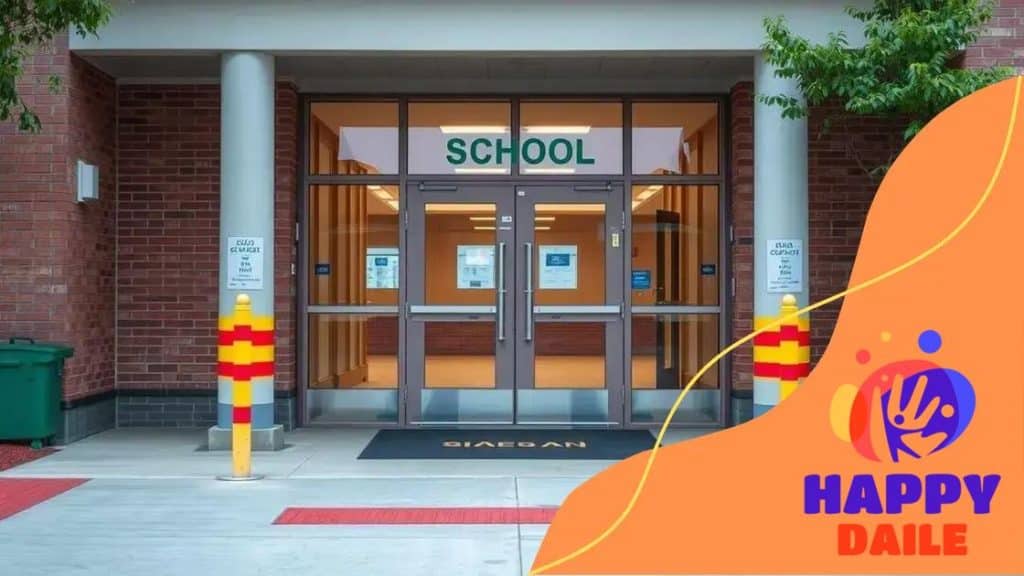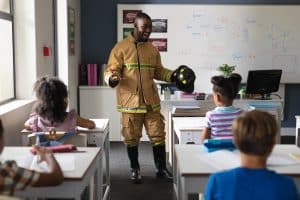School Safety Measures 2025: A Quick Overview

Anúncios

Want to know how today’s schools are adapting to new safety needs? School safety measures in 2025 are evolving fast to protect students and staff alike.
Anúncios
From high-tech solutions to community-led initiatives, schools across the country are implementing smarter and stronger approaches to ensure peace of mind for families and educators.
Let’s dive into the critical components that make our schools safer, and what you should know to stay informed.
Understanding the Current Landscape of School Safety in 2025
To create effective school safety measures, it is essential to understand the challenges schools currently face. Safety in educational institutions now goes far beyond preventing physical incidents.
It includes protecting emotional health, managing digital threats, and preparing for environmental emergencies. Schools must respond to a broader range of risks than ever before.
Anúncios
Evolving Threats in the School Environment
Recent national data show that more than 70% of U.S. public schools have reported incidents related to violence, theft, or other crimes. Bullying, both in person and online, continues to be a major issue.
At the same time, emotional distress, anxiety, and depression among students are rising, creating additional pressure on educators and staff.
Security concerns also include the growing risk of intrusions and targeted violence. In response, over 90% of schools now have formal safety plans, including lockdown and active shooter protocols.
Emergency preparedness for natural disasters has also become more structured due to climate-related events, requiring schools to run regular evacuation and shelter drills.
These trends make it clear that school safety measures must address a spectrum of physical, emotional, and environmental threats.
Shifting Approaches to Prevention and Response
To meet modern demands, schools are investing in more comprehensive safety frameworks. These include updated surveillance systems, entry management controls, and real-time alert platforms.
Many institutions now use technology to monitor behaviors, track safety incidents, and support faster emergency responses.
Staff training has also evolved. Teachers and school personnel receive instruction on how to identify early warning signs of distress, de-escalate conflicts, and respond to crises with confidence.
Simulations and drills help embed these procedures into daily school culture, improving readiness across all levels.
Importantly, safety is no longer just the responsibility of the administration. Students are encouraged to report suspicious behavior, and peer-to-peer education has become a valuable tool for building awareness.
By empowering students to be part of the solution, schools reinforce a collective sense of responsibility.
A Multi-Layered Safety Mindset
Today’s most effective school safety measures rely on multi-layered strategies. Schools are partnering with local law enforcement, mental health professionals, and families to build a safety network that is both preventive and responsive.
These partnerships enable faster decision-making, better resource allocation, and community trust.
According to national research, schools that implement holistic safety programs, combining physical security, mental health resources, and stakeholder engagement, are better equipped to handle crises and prevent long-term issues.
Understanding this current reality is the foundation for shaping smarter, more inclusive safety policies. As we move forward, school communities must continue to adapt, innovate, and stay connected in order to protect every student and educator effectively.
Key safety protocols every school should implement
The role of technology in enhancing school security

The integration of technology into education is not limited to learning, it plays a growing role in how schools ensure security.
Modern school safety measures are increasingly dependent on smart tools that detect threats early, streamline emergency response, and build a safer atmosphere for everyone on campus.
Technology empowers schools to move from reactive solutions to preventive strategies, making campuses more secure and efficient in managing risk.
Smart Security Systems on Campus
Advanced security systems are now standard in many school districts across the U.S. These systems include:
- High-definition surveillance cameras, which monitor hallways, entrances, and open spaces in real time, helping deter dangerous behavior and support investigations.
- Electronic access control, using ID cards or biometric scans, ensures only authorized individuals can enter school buildings.
- Emergency alert systems, capable of instantly sending messages to students, staff, and families, are crucial for fast response during lockdowns or evacuations.
- Intrusion detection sensors, which trigger silent alarms and automatically notify law enforcement, provide an extra layer of protection against unauthorized entry.
These technologies form a powerful front line of school safety measures, helping administrators act swiftly and decisively when threats arise.
Real-Time Communication and Student Involvement
Technology also plays a key role in improving communication during crises. Emergency notification apps now allow alerts to be sent to entire school communities within seconds.
This real-time coordination saves lives by reducing response time and confusion.
Students can also report suspicious behavior anonymously through mobile apps or online platforms. By empowering students to participate in school safety measures, schools foster a shared culture of responsibility and vigilance.
Data-Driven Safety Decisions
One of the most impactful benefits of technology is its ability to generate actionable data. Schools can now track trends in security incidents, identify recurring issues, and adjust protocols based on real evidence.
For example, by analyzing the timing and location of past incidents, administrators can reassign security personnel, add new cameras, or update training programs to address high-risk areas.
These insights help schools refine their school safety measures continuously, staying ahead of new threats.
Additionally, virtual reality and simulation-based training programs are helping staff and students practice emergency scenarios in realistic environments.
This tech-enhanced preparation increases confidence and ensures protocols are not just memorized but experienced.
Moving Forward with Smarter Safety
As schools continue to modernize, technology will remain central to building safer, more resilient educational environments.
The combination of smart surveillance, instant alerts, data analytics, and digital engagement forms a robust structure for today’s school safety measures.
By investing in the right technologies and ensuring that staff and students are trained to use them effectively, schools can create a future where safety is not an afterthought—it’s built into the system.
Training staff for effective emergency responses
Investing in staff preparedness is one of the most impactful school safety measures a school can adopt. Educators and school personnel are not only responsible for teaching but also for guiding and protecting students during emergencies.
Their ability to act swiftly and confidently can determine the outcome of critical situations.
In recent years, the importance of structured emergency response training has grown significantly. Schools are now expected to prepare their teams for a wide range of scenarios, including natural disasters, medical emergencies, and security threats.
The Importance of Prepared Staff
Well-trained staff are the backbone of a secure learning environment. Their familiarity with safety protocols allows for calm, coordinated responses in high-pressure situations.
Effective school safety measures begin with ensuring that every adult in the building knows what to do and when to do it.
Key focus areas in training include:
- Identifying early warning signs of danger
- Executing evacuation and lockdown procedures
- Managing injuries until professional help arrives
- Supporting students during behavioral or emotional crises
By practicing these skills regularly, staff build the muscle memory necessary to respond without hesitation.
Comprehensive Training Programs for School Personnel
The most successful training programs go beyond basic instructions. Schools are increasingly offering hands-on, scenario-based workshops that mirror real-life emergencies.
According to national data, over 95 percent of public schools now conduct drills multiple times a year, often in collaboration with local emergency services.
Examples of training programs include:
- Fire evacuation drills practiced across different times of day
- Active intruder simulations conducted with law enforcement
- CPR and first aid certification for teachers and support staff
- De-escalation techniques to address behavioral disruptions
These sessions give educators the tools to act effectively while reducing fear and confusion among students.
Community Partnerships Enhance Emergency Preparedness
Strong school safety measures also depend on relationships with external agencies. Local police, firefighters, and emergency medical teams often play a direct role in preparing school staff through joint exercises and consultation sessions.
These partnerships provide valuable insights and keep protocols aligned with the latest safety standards.
Schools that engage parents in safety planning also see stronger support networks. Informational meetings, family drills, and safety guides sent home help caregivers understand how to respond in coordination with school actions.
This shared understanding promotes consistency between home and school, reinforcing a community-wide commitment to student safety.
Creating a Culture of Confidence and Readiness
Training empowers educators to take control during emergencies, but it also influences daily habits.
A staff that feels equipped to handle crises is more likely to notice unusual behavior, enforce safety policies consistently, and model calm leadership for students.
Effective school safety measures are not just about responding to danger. They are about preventing it through awareness, confidence, and preparation.
Schools that prioritize ongoing training build a culture where every adult is ready to protect, lead, and support.
As we look ahead, it is clear that schools with well-prepared staff are better positioned to provide both security and peace of mind.
Engaging the community in safety initiatives
For school safety measures to be truly effective, they must extend beyond the walls of the school building. A safe learning environment depends not only on internal policies but also on strong, active partnerships with the surrounding community.
When families, businesses, and local organizations work together with schools, they create a comprehensive support network that strengthens every layer of protection.
How Parental Involvement Strengthens Safety
Parents are essential partners in maintaining a safe school climate. Their participation in school activities, committees, and safety discussions fosters a sense of shared responsibility and transparency.
Engaged parents help reinforce school safety measures by:
- Joining school safety committees and contributing ideas
- Attending informational meetings and workshops on emergency protocols
- Volunteering during drills and school events to support staff
- Communicating concerns or suggestions directly to school administrators
This involvement creates a consistent message for students, showing that safety is a community priority both at school and at home.
Collaborating With Local Businesses and Organizations
Local businesses can play a valuable role in supporting school safety measures through resource-sharing and sponsorship.
Whether by donating safety equipment, funding awareness campaigns, or providing professional expertise, these partnerships enhance the capacity of schools to implement well-rounded safety plans.
For example, companies with cybersecurity expertise can assist schools in protecting student data and educating staff on digital threats.
Others may offer emergency supplies or logistical support during drills. These collaborations help schools operate more efficiently and safely.
Promoting Awareness Through Community Campaigns
Raising awareness is a key component of long-term school safety. Public campaigns focused on bullying prevention, mental health support, and crisis readiness help unify the community around a shared goal.
Schools can lead these efforts by:
- Hosting forums and town halls with safety experts and first responders
- Publishing regular newsletters or updates on safety improvements
- Using social media to distribute tips, alerts, and educational content
- Encouraging students to involve their families in school safety discussions
When communities are informed and actively involved, they are more likely to respond constructively in times of crisis and more invested in preventing future risks.
Building a Unified Culture of Safety
The most successful school safety measures are those supported by an informed and engaged community.
When parents, educators, business leaders, and students all understand their role in maintaining security, the result is a safer and more connected school environment.
By making community engagement a permanent part of safety planning, schools foster trust, build resilience, and promote a culture where every voice contributes to collective well-being.
This inclusive approach not only improves safety outcomes but also reinforces the values of empathy, collaboration, and accountability.
Evaluating the Effectiveness of School Safety Measures

Evaluating the effectiveness of school safety measures is essential to ensure that schools are not just prepared on paper but truly equipped to protect students and staff. Implementation alone is not enough.
Without consistent assessment, protocols can become outdated or fail to meet the evolving needs of the school community.
Regular evaluation allows schools to identify weaknesses, strengthen successful strategies, and adapt to new challenges with greater confidence.
How schools measure what truly works
The evaluation process begins with listening to the people inside the school. Many schools conduct surveys to gather student and staff feedback about how safe they feel during the school day.
These insights are often more telling than incident reports because they reveal hidden concerns and emotional responses that policies might overlook.
Incident data also plays a crucial role. By reviewing reports on safety breaches, behavioral issues, or emergency drills, school leaders can identify patterns that point to larger gaps in their safety systems.
Observing how students and staff respond during actual drills provides additional clues. If participants hesitate or misinterpret instructions, it may signal the need for clearer training.
Community feedback adds another valuable layer. When parents are invited to participate in safety discussions or review policies, they often bring fresh perspectives or highlight real-life issues that schools may not see internally.
This open communication strengthens trust and creates shared accountability for outcomes.
Setting clear standards for safety success
To evaluate school safety measures effectively, schools must define clear goals and standards.
These benchmarks may include measurable indicators such as response times during drills, a decrease in safety-related incidents, positive feedback from students and staff, and a demonstrated understanding of safety protocols among school personnel.
These criteria help schools track progress over time and compare results year by year. Evaluation is not only about identifying problems but also recognizing what works well and reinforcing those strategies across the campus.
Turning insights into meaningful action
Evaluation means little if it doesn’t lead to improvement. Once the results are reviewed, schools must act quickly to make necessary adjustments.
This might involve updating emergency plans, expanding training sessions, investing in better communication tools, or increasing mental health resources.
Timing is key. When changes are made promptly after evaluation, the school community feels heard and supported.
This responsiveness builds credibility and reinforces the idea that school safety measures are a living system—constantly improving rather than sitting static in a policy manual.
Creating a culture of ongoing safety review
Truly effective schools treat evaluation as a routine, not an occasional event.
When the review of school safety measures becomes a regular part of school operations, it ensures that the institution remains agile, data-informed, and responsive to both current risks and future uncertainties.
This culture of continuous improvement helps schools stay one step ahead. It also signals to students, families, and educators that their well-being is a top priority every single day.
In a world where threats can evolve rapidly, the schools that monitor, adapt, and refine their safety practices are the ones best positioned to offer secure and supportive learning environments.
Conclusion: The Ongoing Importance of School Safety Measures
In today’s educational landscape, school safety measures are more than a precaution, they are essential to maintaining a safe, inclusive, and supportive learning environment.
With new and evolving challenges, schools must continuously assess and enhance their strategies to protect both students and staff.
A truly effective approach combines physical infrastructure, like access control systems and surveillance cameras, with community involvement and staff preparedness.
These school safety measures not only prevent threats but also build trust and resilience within the school community.
Educational leaders now recognize the importance of integrating mental health support, transparent communication, and data-driven decisions.
According to recent research from the National Center for Education Statistics, over 90% of U.S. public schools have formal plans for emergencies, including active shooter situations.
This underscores how crucial it is to have updated and reliable protocols in place.
Additionally, organizations like the National Center for School Safety emphasize a holistic view of safety, combining emotional well-being, inclusivity, and crisis response as part of everyday school culture.
Looking ahead, the success of school safety measures will depend on collaboration across all levels, educators, parents, students, community leaders, and policymakers.
By staying informed, remaining engaged, and investing in proven strategies, we can ensure that every student has the opportunity to learn and grow in a safe, nurturing environment.
FAQ – Frequently Asked Questions about School Safety Measures
What are the key safety measures schools should implement?
Schools should implement access control, emergency communication systems, regular drills, and visible security personnel to enhance safety.
How can parents get involved in school safety?
Parents can join safety committees, attend workshops, and volunteer during safety drills to support school safety efforts.
Why is training staff important for school safety?
Training staff equips them with the knowledge and skills to respond effectively during emergencies, ensuring the safety of students.
How can schools evaluate the effectiveness of their safety measures?
Schools can evaluate effectiveness by collecting data from surveys, incident reports, and analyzing response times during drills.
Liked the article?





